
25 minute read
Idaho Makers: Window Dressing
Idaho Makers
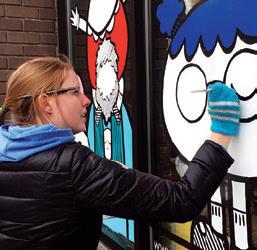
Window Dressing
BY HEATHER HAMILTON-POST
Tiffany Eller's Little Cuties exist in several forms, but recently, you may have seen them on the windows of Shift Boutique in downtown Boise. They’re big and small and everything in between, glasseswearing, freckled, and totally rocking out. Of course, they’ve gone the way that window paintings do in extreme weather, but Eller says they’ll be back in September when Treefort returns.
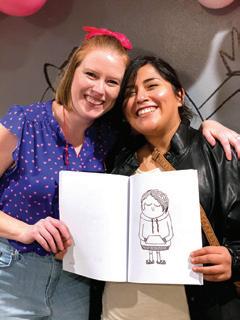
“When I was chosen to paint for Treefort, I thought, oh my gosh, now I have to learn to paint a window!” Eller says. Typically, she works with pen and standard sized paper, so adjusting her artwork to appear in gigantic window form took some learning, and a surprising amount of paint she says. Luckily, she had help from friends (some of whom have actually inspired their own Little Cuties) along the way.
The Little Cuties, which you can see in more detail at Moonbabyarts. com, have been around since October, when Eller started participating in a daily drawing challenge via Instagram that focused on body positivity. “I started posting body positive Little Cuties every day for the month of October. And I got so many requests to make a coloring book that I thought, ok, cool. I know how to do that,” she says. The book, which was crowdfunded, comes complete with a glossary describing what each character represents. Eller does her best to make sure they’re diverse, noting that the body positivity movement sprung from fat activism and fat liberation. “Then it kind of got co-opted by people like me--white women in straight sized bodies. And so I try to be really cognizant about what I’m sharing and to think not so much how bodies look but how we feel about our bodies,” she explains.
Eller also explores body diversity and body shame in The Body Story Podcast, a weekly podcast in which she invites people to tell their own body stories. “I’ve interviewed a mermaid who identifies herself as a fat mermaid. I’ve interviewed people who have had bariatric surgery, or people that have lost a limb or lost their ability to move their limbs,” she says. “And, as I’ve made Little Cuties, it’s shifted my body story because it forces me to think of things in a new way and to try to think of experiences that I haven’t undergone myself.”
Eller’s mom is an artist too, so she grew up making art, but says she struggled to find a medium that she really connected with. She describes how, when she let go of “all the shoulds” about her art, she found a career in graphic design, which led to Little Cuties which led, eventually, to painting a window on a downtown storefront.
PROMOTING THE RESPONSIBLE DEVELOPMENT OF OUR COMMUNITY SINCE 1956
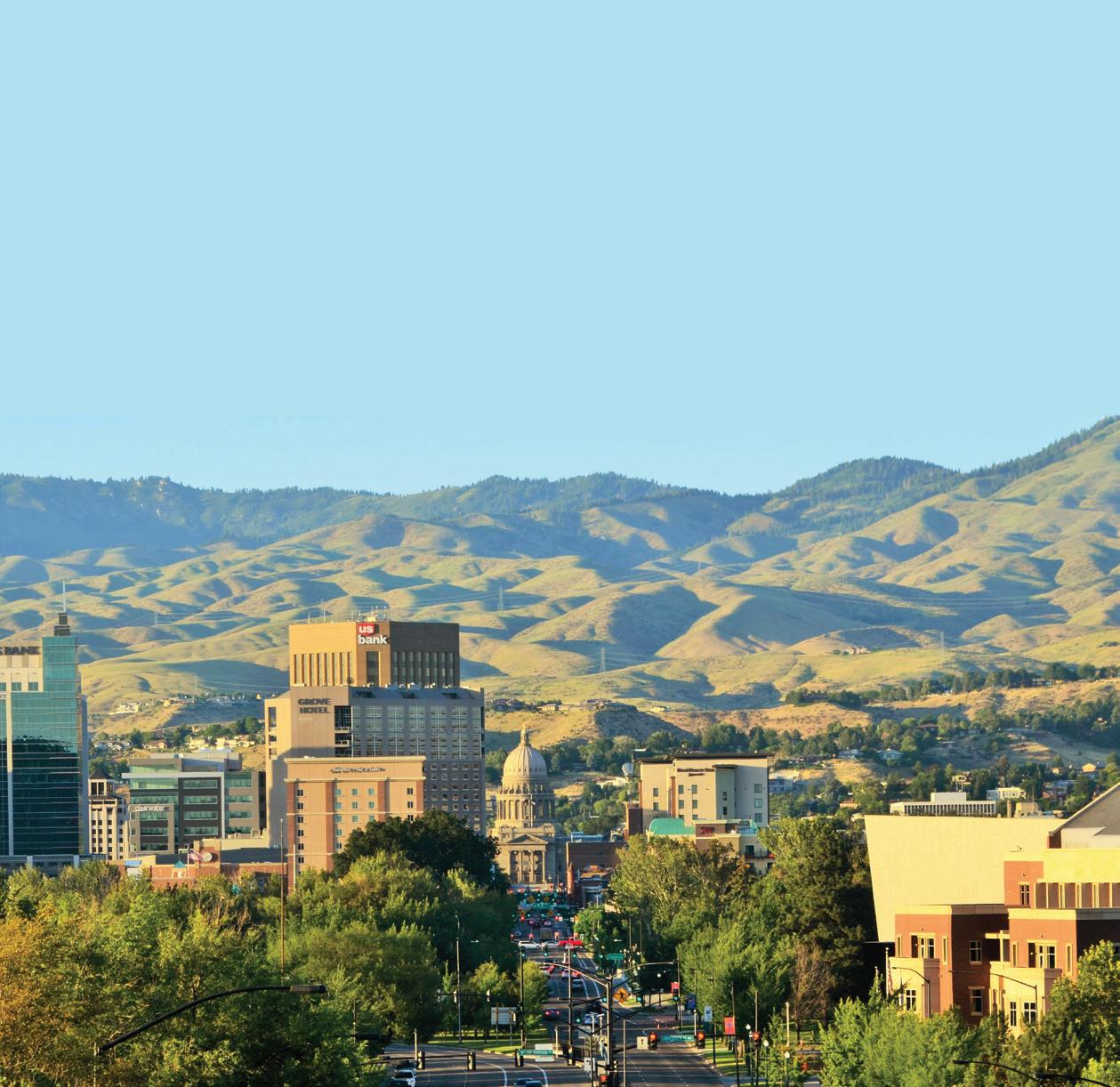


AFFORDABLE HOME OWNERSHIP FOR ALL WHO ASPIRE TO IT
Through service and advocacy, we’ve reduced the cost of new construction roughly $19,000 per home in 2018-2019.
BY HEATHER HAMILTON-POST | PHOTOS BY JOHN KELLY, BSU VISUAL SERVICES.BY HEATHER HAMILTON-POST | PHOTOS BY JOHN KELLY, BSU VISUAL SERVICES.
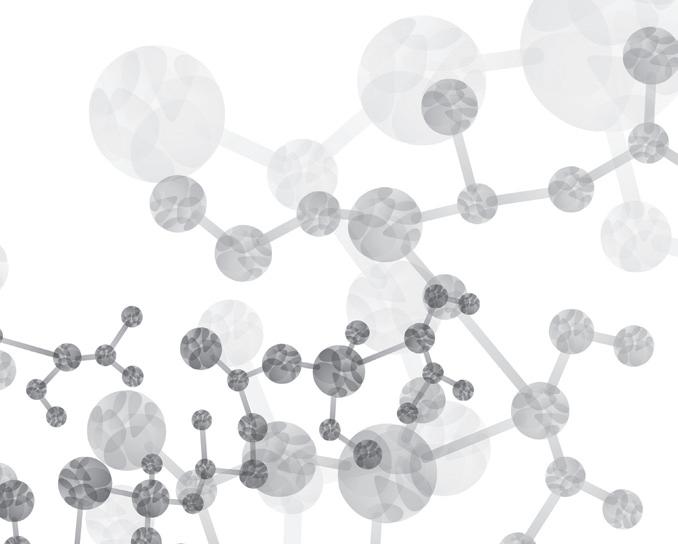
The Critical Things: How DNA Is Driving Idaho ExonerationsHow DNA Is Driving Idaho Exonerations
Content Warning: This story contains brief mention of crimes involving the kidnap, rape, and murder of various people, including children.
Idaho is one of only 15 states across the country that does not offer compensation for the falsely convicted, no matter their time served or circumstances under which they were incarcerated. This year, Rep. Doug Ricks, a lawmaker from Rexburg, Idaho sought to change all of that with a bill that would provide $60,000 per year of wrongful incarceration, or $75,000 per year for those on death row. The bill added additional reparations for years on parole or the sex offender registry and services like health insurance, mental health care, tuition and job assistance, and housing services, among others. In Idaho, released inmates receive many of these upon their release--not so for the wrongly convicted.
On March 31, Gov. Brad Little vetoed the bill after it passed in Idaho’s House and Senate, citing a flawed process. He wrote that the objective of the bill was admirable, but noted that the ““bill immediately forces the state into an adversarial legal proceeding in court with the claimant.” Instead, he said, the goal would be better and more quickly accomplished through an existing state board and commission that would review these cases. Rep Ricks says that he’ll reintroduce the bill on the first day of the 2021 legislative season and that Gov. Little has said he’ll work to get a bill passed.
Greg Hampikian, who founded the Idaho Innocence Project at Boise State University and now serves as co-director alongside Robin Long, helps in the exoneration of wrongly incarcerated people throughout the world. In recent history, they’ve freed people in Georgia, Montana, and New Mexico, and helped start Innocence Projects in Ireland and Armenia, often training people in Boise. Idaho cases are handled as the Idaho Innocence Project, and others as the Forensic Justice Project.
Hampikian says that Rep. Rick’s bill was good, noting that it involved a lot of hard work and consultation with legal professionals, prison administration, etc. “It was a legislative tour de force, and it was well negotiated,” he adds. Eventually, Hampikian would also like to see a plan in place that expunges or seals the vast assortment of records that accompany a conviction, even when it is overturned.
Because, while it may not seem like it, this is a significant issue in Idaho. The National Registry of Exonerations lists six people since 2001 to be exonerated, two based on DNA evidence. Most recently, Christopher Tapp, who spent 20 years in prison for a rape and murder he had no part in and could not be tied to with physical evidence.
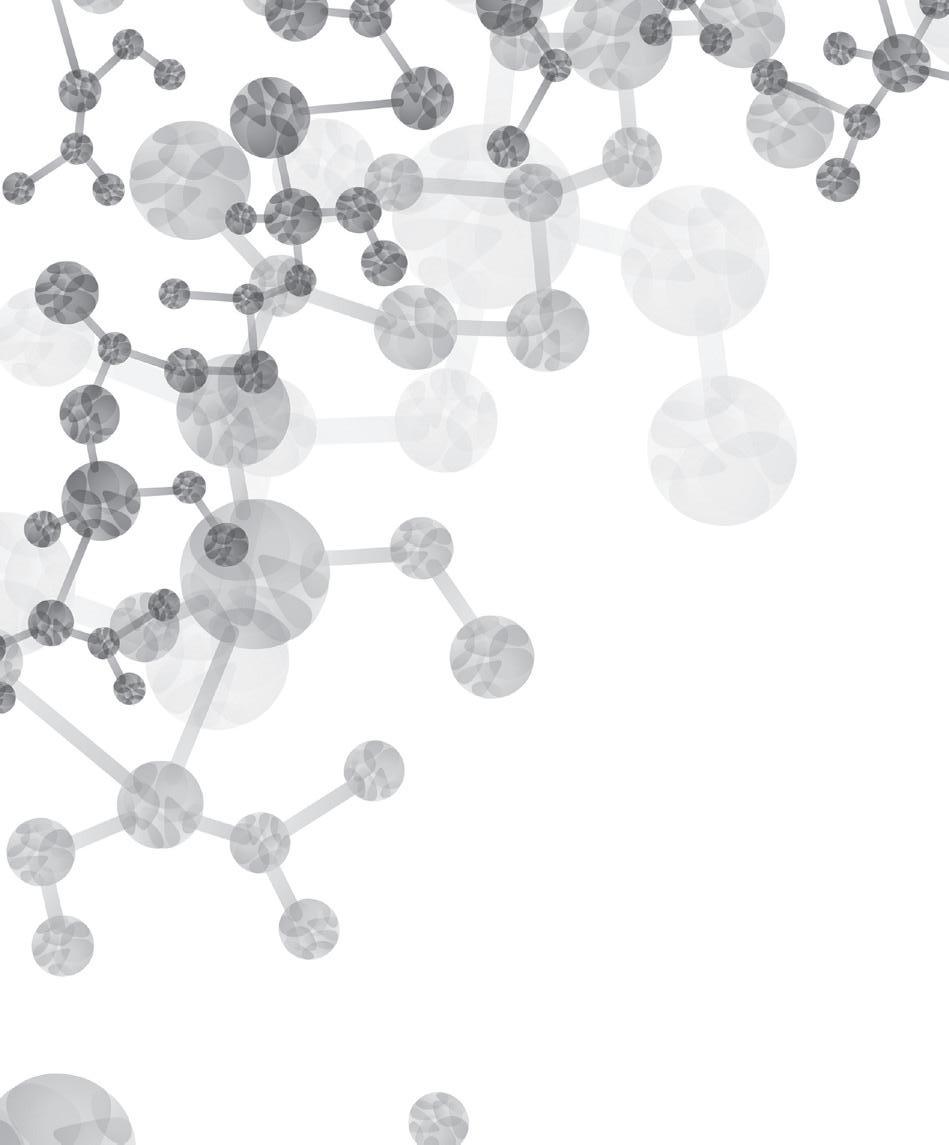

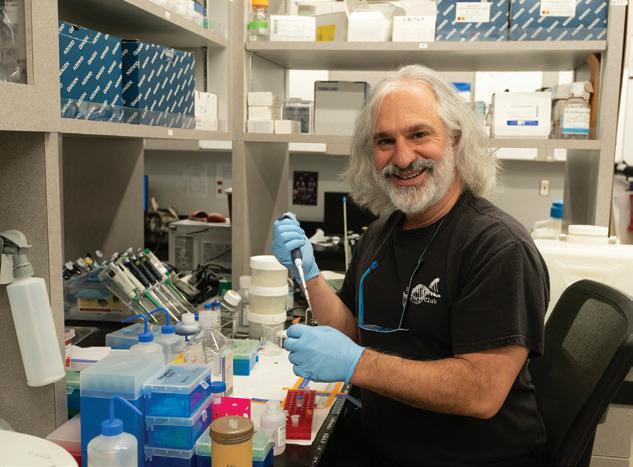
Forensic scientists Greg Hampikian and Janet Layne work in the lab at BSU on local cases and cases around the world.

Instead, police coerced a confession that resulted in a conviction. Hampikian is the only Innocence Project director who also works as a forensic scientist with a lab, which allows him to accomplish things in his lab that may be hard to do in other places. His team, for example, supplied the last name of the actual perpetrator in the Angie Dodge case in which Tapp was originally convicted.
Idaho’s Innocence Project was inspired by the exoneration of former Idaho inmate Charles Fain was arrested for the kidnapping, rape, and murder of Daralyn Johnson based on the resemblance of his hair to one found at the crime scene, which Hampikian says happened fairly often because investigators were trained to look for those kinds of things. “This stuff isn’t total junk science--dental, shoe prints, hair-- they all have a place. But they’ve all been abused. If we have a better tool, we should use it,” he says.
Hampikian explains that the best of identifying sciences rely on databases that allow evidence to be examined based on individual characteristics, which wasn’t possible with the hairs in this case. “There are people that have been convicted based on the fact that dogs sounded off when they say them,” he says. “Sometimes, just because the science is good, it doesn’t mean the application is correct.”
And Fain, who has yet to receive anything from the state of Idaho despite his 2001 exoneration, harbors no hard feelings, and has said he’d give any restitution to his family and exwife. Fain has said he always held out hope that he’d get out, never planning his last meal or last words. And, despite the testimony of jail informants promised plea agreements for accusing him of a graphic confession, eventually he did get out.
“Charles Fain is the most sanguin, cool headed, Christian dude I’ve ever known. He sees everything as a turning of God’s wheel. Nothing will shake him, and he doesn’t think that life owes him anything,” Hampikian says. “He was, at one point, two days from execution. Charles has been a real education for me about human character. He’s an amazing person.”
There are even more heartbreaking cases too, Hampikian explains--cases where things just don’t work out. “We’re always told that evidence has been lost or is contaminated. We’ve found rape slides in prosecutor’s desks and evidence in the attic of retired police officers. If agencies are willing to work with us, it can be simple to test things. When they fight us, it can take years.” In Idaho though, he says, they’ve had a lot of cooperation.
Thankfully, there are successes too, and Hampikian says he’s had a few good cries when people are freed after years of work. He recalls phone calls from exhausted parents, and the joy of celebratory hugs when a family member is freed, often after 10 plus years of exhaustive work and travel. The real joy of his work, Hampikian says, is meeting people along the way--he’s in touch with both Fain and Tapp, whom he considers friends. And, while work is more difficult in a global pandemic, it isn’t impossible. “We’re getting done the critical things that we have to do,” he says.
BY HEATHER HAMILTON-POST | PHOTOS COURTESY CITY OF BOISE OFFICE OF THE MAYOR.
This Is Not a Drill Mayor McLean’s Unprecedented First Months in Office
26 www.idahomemagazine.com
says Boise Mayor Lauren McLean, who has served as Boise’s mayor since only January. “And so it’s been important for our team to recognize, while balancing the needs of a transition of administration, the need to protect public health, and responding to the economic crisis, the need for agility and nimbleness--a willingness to be comfortable making decisions that nobody’s ever had to make before,” she says.
She and her team, which wasn’t even entirely assembled when the pandemic began, are certainly in uncharted territory, though they’ve been quick to respond to crisis. Through it all, she says, they’ve tried to remain focused on what they heard during the election--the need for affordable housing and economic opportunity. In fact, McLean recently announced proposals for $1.5 million of new projects aimed at pandemic recovery and clean energy.
McLean says that she believes that innovation will help solve what she calls “the unique challenges of our time”, which includes significant changes to Boise’s budget to include potential cuts from maintenance and operations as well as to the general fund. As part of pandemic relief, she’s proposing $100,000 for eviction programming, which would help ensure that Idahoans stay housed--more important than ever, given that so many of us are even working from home now.
Until recently, McLean was working from home full time too, facing the same challenges as everyone else, which included coworking with her husband and helping her own children finish their years of college and high school--and all of that happening in the same space. To stay sane, they’re keeping active and maintaining positivity and connection with the community. McLean says that her husband is baking bread with a sourdough starter he made and is sharing, her son is mountain biking with her, and her daughter is making sweets and joining her for runs. Boise’s mayor is averaging about 40 miles per week right now, which she says is helping her to manage some of the stress. “As I was having to make really tough decisions, I started running a lot more, as many people did. If you have to quarantine or self-isolate, Boise is the place to be,” McLean laughs. “I’ve been reminded of how much I love this place.”
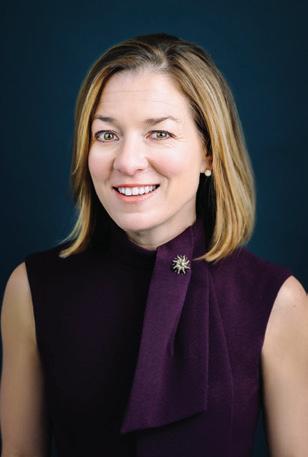
McLean, who is now recognized when she runs, even with a mask, says she’s getting better at recognizing other folks in masks too. On the trail, she says she’s had the chance for some impromptu and socially distanced meetings with her constituents, which she calls “a joy”. Known on the campaign trail for her desire to connect face to face, she’s making due now.
“I’ve found that we’ve had to come together as we’ve stayed apart in new ways. I’ve continued my listening sessions, but they’re virtual now. People can send questions in advance. My press huddles are now weekly so that I can update them
40 MILES
To manage stress, McLean gets in about 40 miles of running a week.
and answer questions. We hold council meetings through Zoom, and I’ve had a lot of interactions with different organizations and constituencies throughout the city through digital platforms. It’s not the same because you don’t get that same energy, but we’ve trained ourselves, quickly, to connect in different ways,” McLean says. She emphasizes that she’s still committed to putting leaders out there to hear from the public and stand accountable to their actions--it just looks a little different now.
Her commitment stems from the inspiration she finds amongst the community, which is filled with stories of sacrifice in the name of community good. She’s inspired by city staff and community leaders who have had to adapt quickly to so much change. “I’ve always believed that in Boise, the something that makes us so special is our connection to the place in which we live and the people we live with. And, while we’ve been separated from the people, it’s been really incredible to see the importance of that people connection and place connection come through. The efforts that citizens and business people and others have made to think about how we connect differently--I believe we’re stronger for it, more resilient because of it,” McLean says.
And, while she describes stepping off the elevator and suddenly missing the hubbub and the noise that is, in most times, normal at Boise City Hall, McLean is committed to doing what it takes to make Boise safe. Her days look different right now. Instead of office hours, she sits before a computer most of the day, though she is in regular communication with council members, community leaders, businesses, and public health officials to find a path forward that balances safety, economy, community.
Though these circumstances are not ideal, McLean is learning a lot, and hopes to bring into the future the good parts of this--a more digitally accessible Boise City Hall, for example, as well as the relationships and partnerships she’s formed in the interest of informed decision making and action. “I’ve learned to speak honestly and openly with the public about what we know and what we wish we knew, and why we’re making the decisions we’re making, which will inform the way I continue to work with the public during the next couple years of my term,” McLean says. Although this has been a crash course like no other, McLean says that it has made space to reflect on the sacrifices of people within our community and our ability to look out for one another. “I’m very honored to be where I am at this moment of time. I’ve learned to feel comfortable and confident making decisions that have to be made and to stay focused on our long term goals as a city, which is to create a community for everyone with a thriving economy,” McLean says. “I’m inspired by the community and humbled by the opportunity to work with the residents of this great city.”
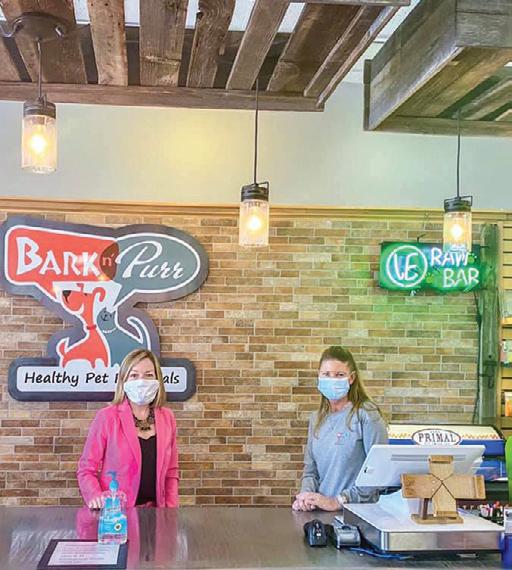
MCCALL · DONNELLY · CASCADE · YELLOW PINE · NEW MEADOWS
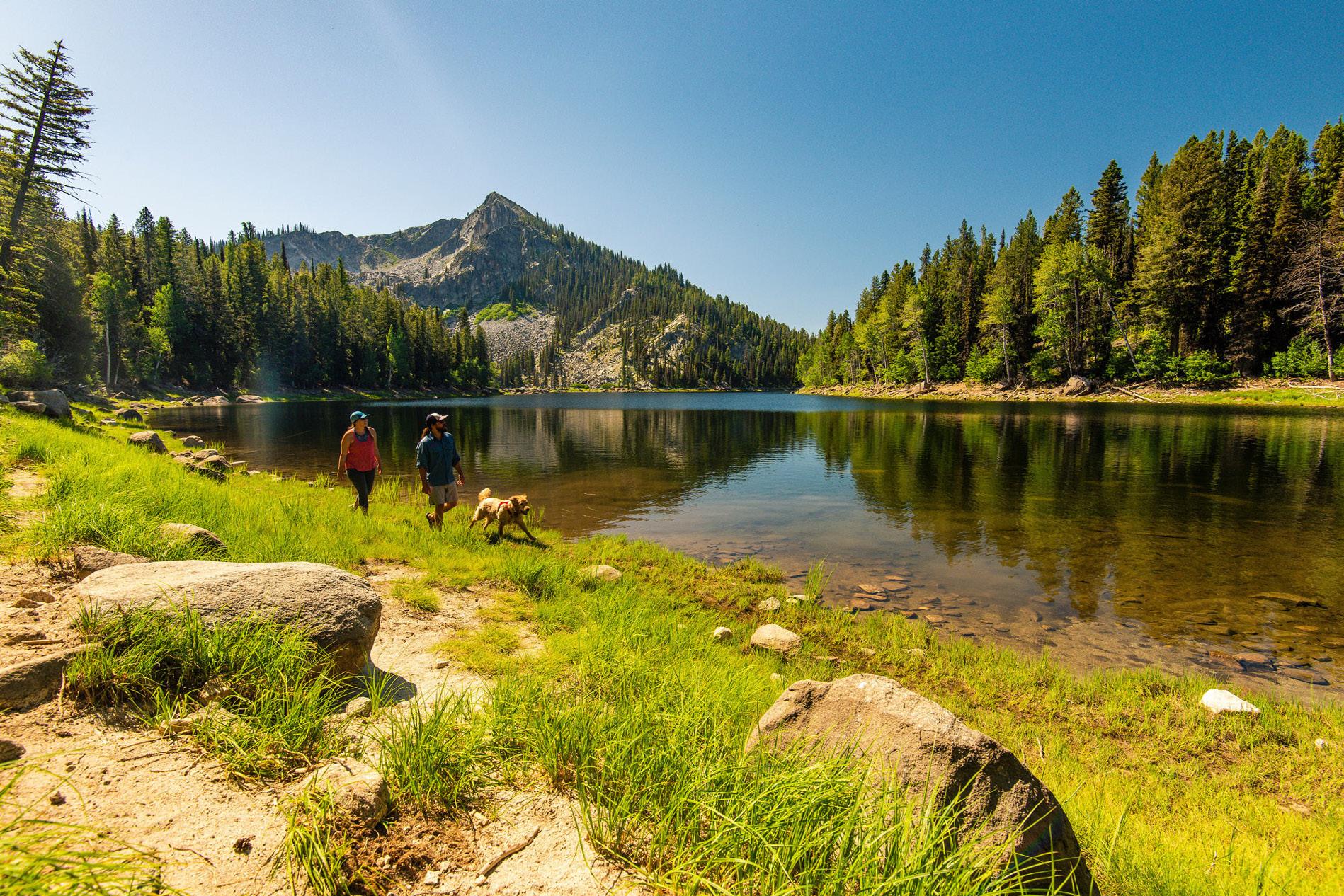



LEARN ABOUT OUR REOPENING PLANS AT PROTECTYOURMOUNTAINPLAYGROUND.COM

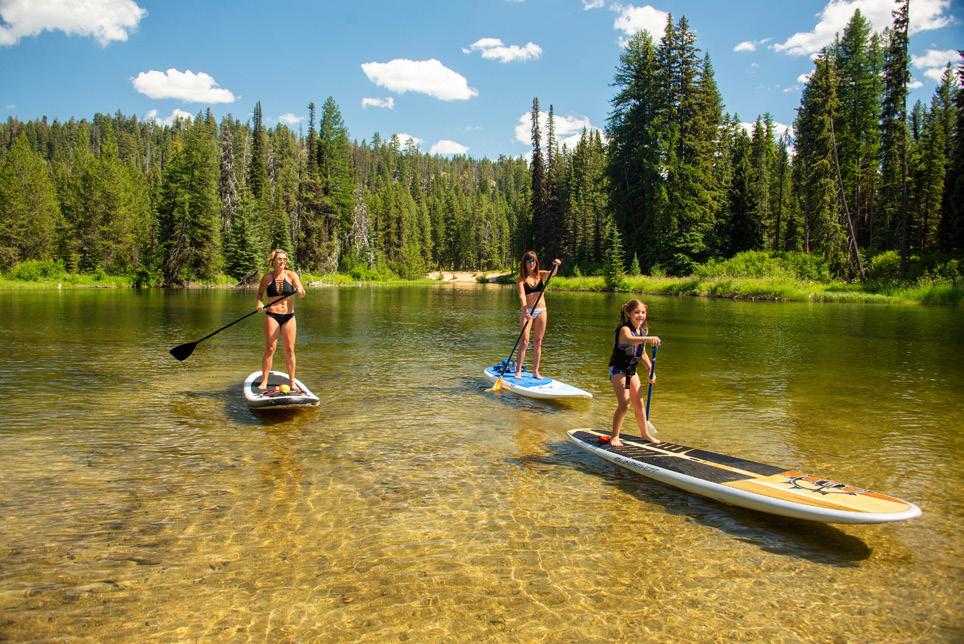

We know this place holds a special place in a lot of hearts. We need your help to protect the place and the people we all love.

MCCALL MOVING FORWARD: How They’re Speaking Fluent Face Mask
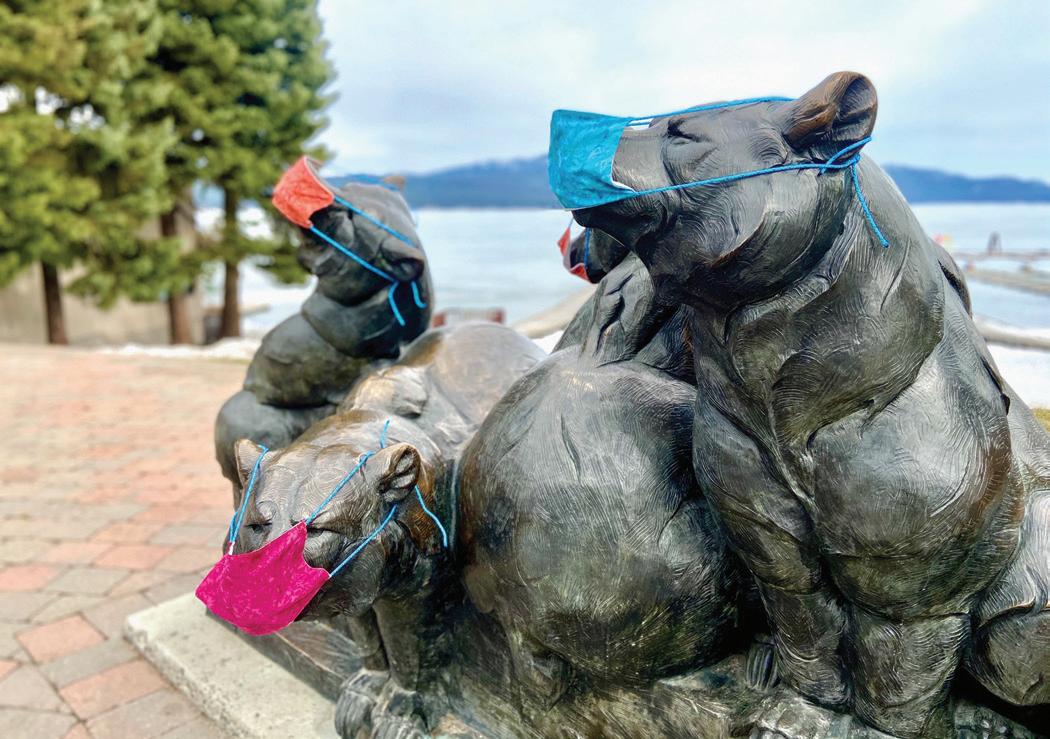
BY ALICE KLEIN
30 www.idahomemagazine.com
Though Idaho’s favorite mountain retreat won’t be hosting a fireworks show this July, they’re eager to get back to business, says McKenzie Kraemer, with the McCall Area Chamber of Commerce and Visitors Bureau. “Our businesses have been amazing at adapting. It is really refreshing to see people think outside the box. It really is challenging, but people rose to the challenge. As we get back to business as usual, I think people are aware of the little things we used to take for granted like having a meal with family and live music--they’re approaching them with a little more gratitude,” she explains.
Kraemer says there are restaurants newly offering delivery, selling to-go cocktails, and even canning beer on the spot. She notes that people are taking the pandemic seriously--so seriously, in fact, that they’ve formed a sort of Valley County Covid-19 task force, which has representation from every city, city government, chamber, county, local healthcare representatives, and even people from local businesses within the various communities- -about 30 people in total. The workgroup contains representatives from McCall, Donnelly, Cascade, Yellow Pine, and, though technically in Adams County, New Meadows.
The group formed with the intent of gathering and sharing information and best practices during the stay at home order, though they’ve now shifted focus to reopening the area, which includes discussions of messaging around tourism, which sustains many of these cities. To ensure efficiency in moving forward, the larger group has subcommittees that focus on government (including state parks and education, as well as relevant issues like feeding school-aged children), business, marketing, and healthcare. At each meeting, the committees report back and members are briefed by Central District Health.
The group is focused on making a safer Valley County, which requires the use of masks. Tom Reinhardt, CEO of Cascade Medical Center, says that people are now coming into the center with the expectation of wearing a mask, which they’re allowed to take home if they need for continued use in the community. “Our bottom line is, if you’re opening, follow all the recommended guidelines. We’re not here to judge you, but we’re here to help you,” he says.
The iconic McCall
bears are safe with masks! Photo by Samantha Sais Photography

Chairs line Payette Lake
at Shore Lodge. Photo by Visit Idaho
Dr. Irvin, who has spoken to the force on multiple occasions, emphasizes the importance of wearing a mask to give a “fighting chance of at least reducing the risk that we’re going to end up with community spread, which we’re trying hard to avoid”. He explains that, through St. Luke’s Adaptive Recovery Collaborative, there will be additional guidance regarding testing and contact tracing, as well as safe returns to work. His recommendations include outdoor dining when possible, masked staff, and appropriate social distancing.
The group says they’ve been sharing a lot of information with Teton Valley, Jackson Hole, Ketchum, and the Wood River Valley, which has been helpful in navigating the specific challenges of opening for tourism amidst a pandemic.
Though they’re all busy doing their day jobs, the taskforce has helped bring mental health care events to fruition, organized discussions for business owners and citizens wondering what their rights are when people question mask policy or other safety protocols, and coordinated resources to help local business. They’re even discussing the possibility of a statewide public service announcement.
Right now, the city of McCall is also looking into the possibility of setting up hand washing stations around downtown like you might see outside at a concert to encourage more frequent handwashing. To enforce their new messaging, they’re putting up signs with their new marketing message--PROTECT YOUR MOUNTAIN PLAYGROUND. The taskforce strives to offer a consistent message, and emphasizes that, while masks are the new normal, it’s because they want to continue to share the area with the rest of Idaho.
The group hopes they can move the needle, just a bit, even though it can sometimes be discouraging when guests arrive at the Shore Lodge sans mask, gather in large groups, or otherwise threaten public safety. Still, they explain that, even if they prevent five or ten people from suffering the effects of Covid-19, it makes a difference.
“We don’t want people to come up here thinking that it’s business as usual, because that’s not the case. We’re open and welcome, but it’s just going to look a little bit different. We want to make sure people’s experience is a positive one, but safe for them and for our residents,” Kraemer says.

31
Sharing information to keep McCall
healthy is the purpose of Valley County Covid-19 task force


Camping During COVID: A New Twist on an Old Adventure
Look, we all get it.
After two months of hiding indoors most everybody is seeking relief in the great outdoors as we navigate the New Abnormal. One of the ironies of our COVID-19 cabin fever is we want to escape home, perhaps venturing to . . . a cabin.
And that works, as long as the cabin’s walls are different from the ones staring back at us for the past two months. But a tent or an RV also provide the needed escape from ennui.
As with everything these days, please know that some things have changed since you were last able to move about freely and flexibility will be needed.
SO, RULE NO. 1: Hand washing remains a priority, even though you’ve come into the outdoors, where truthfully most of the dirt is. The person who had the campsite, bench or table before you can leave virus behind. “People put their hands on things, and that’s how they experience the park,” Perry said. But that makes the park tactile, not scary. Wise campers will bring cleaning supplies and wipe down surfaces likely to have been touched. “Bring your own sanitizer and wash your hands,” Perry advises. “If people do that, we’ll be OK.” RULE NO. 2: Beyond hand washing and general sanitizing, people need to mind their spacing from those who are not immediate family or housemates. Idaho may be more open than a few weeks ago, but that doesn’t mean the now-common sense practices have lost their urgency or effectiveness. At boat launches, give others extra breathing room to get boats into or out of the water. On the trail, stay six feet away from others, enjoying the space separately in somewhat-close proximity. A smile and words easily cover the distance in between.
Perry, the park manager, hopes the shared experience ushers in an era where people look out more for one another.
RECREATE RESPONSIBLY IDAHO,
a partnership of Idaho and federal resource agencies, encourages people to enjoy the outdoors but to do so in a smart way.
Recommendations include:
Stay home if you’re sick to prevent putting yourself or others at risk.
Check before traveling to a
campground, a forest or a fishing hole if you decide to go someplace. Some places are not open or have restrictions.
Spread out – if a trailhead or boat launch in congested, find another place or come back during off-peak times.
Bring adequate supplies (water, food hand sanitizer, toilet paper) to be self-sufficient, ensuring you have a good time and avoiding unnecessary contact with others.
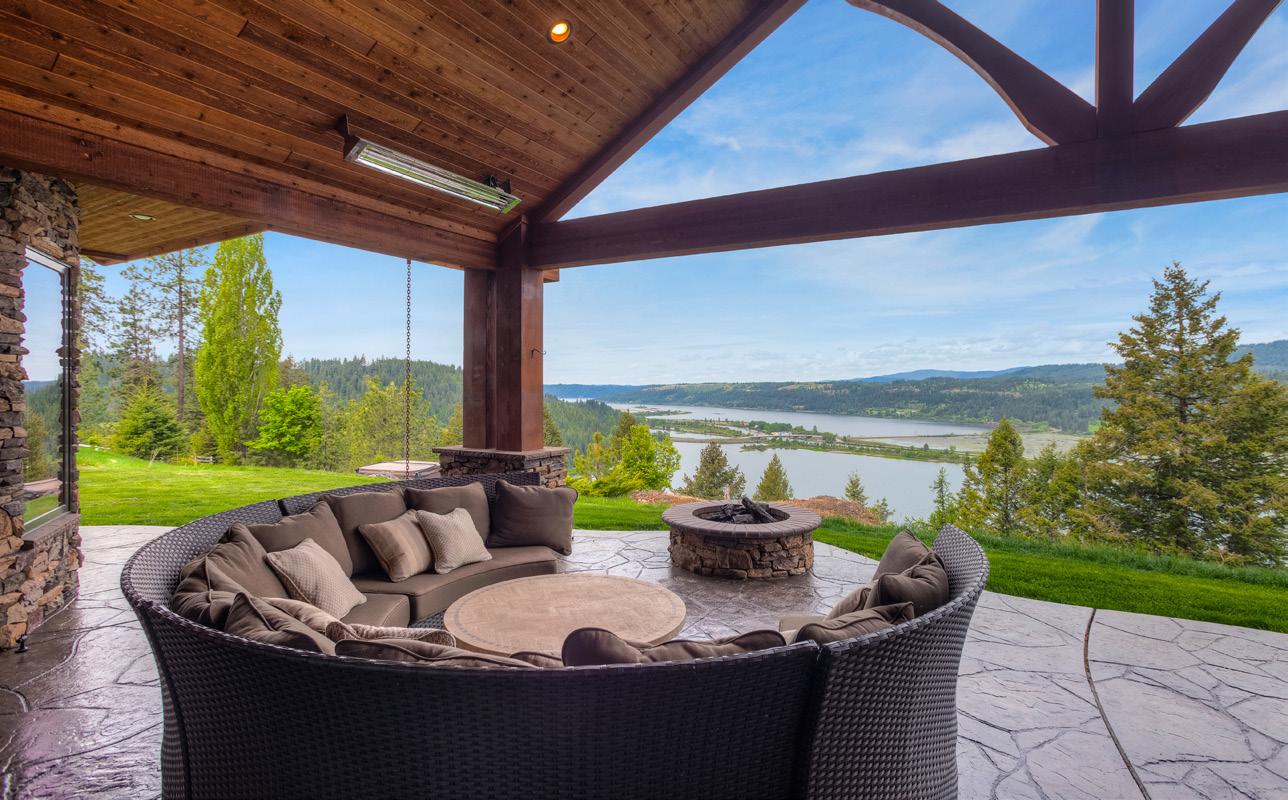
CURTIS FERNEY Broker Associate cferney@fayranches.com (208) 709.0001 Licensed in ID
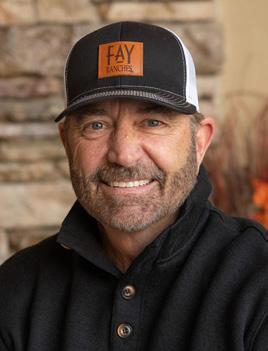



DAVE HALGERSON Designated Broker dhalgerson@fayranches.com (208) 869.8807 Licensed in ID, OR
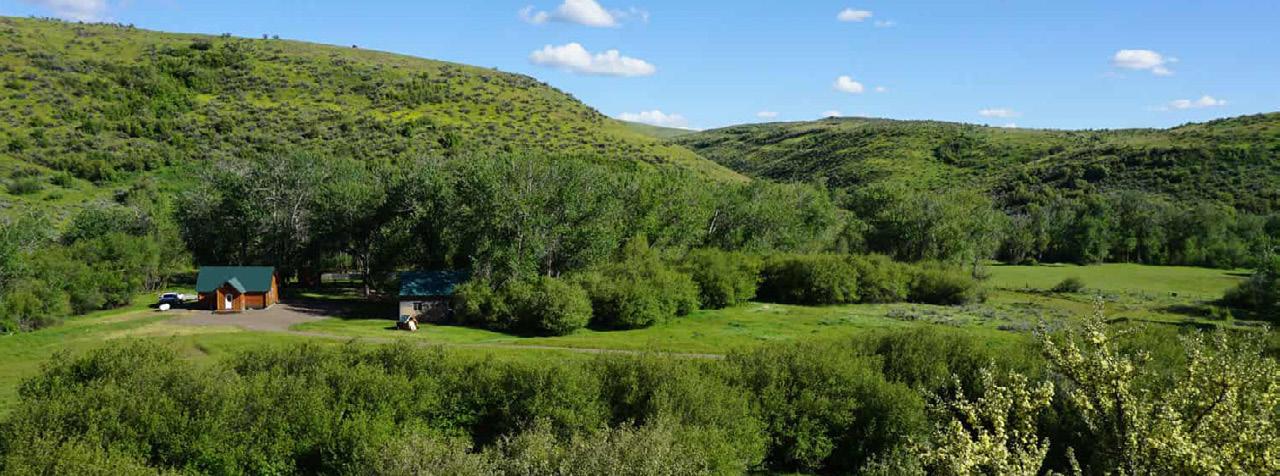

TETON RIVER HEADWATERS Driggs, Idaho 151± acres | $1,980,000


To view details on over $850m worth of exclusive listings and for a complimentary subscription to Land Investor magazine, visit us at: www.FAYRANCHES.com
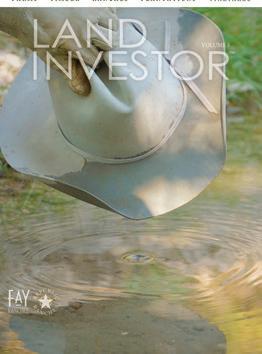

A (Back) Pack of One’s Own
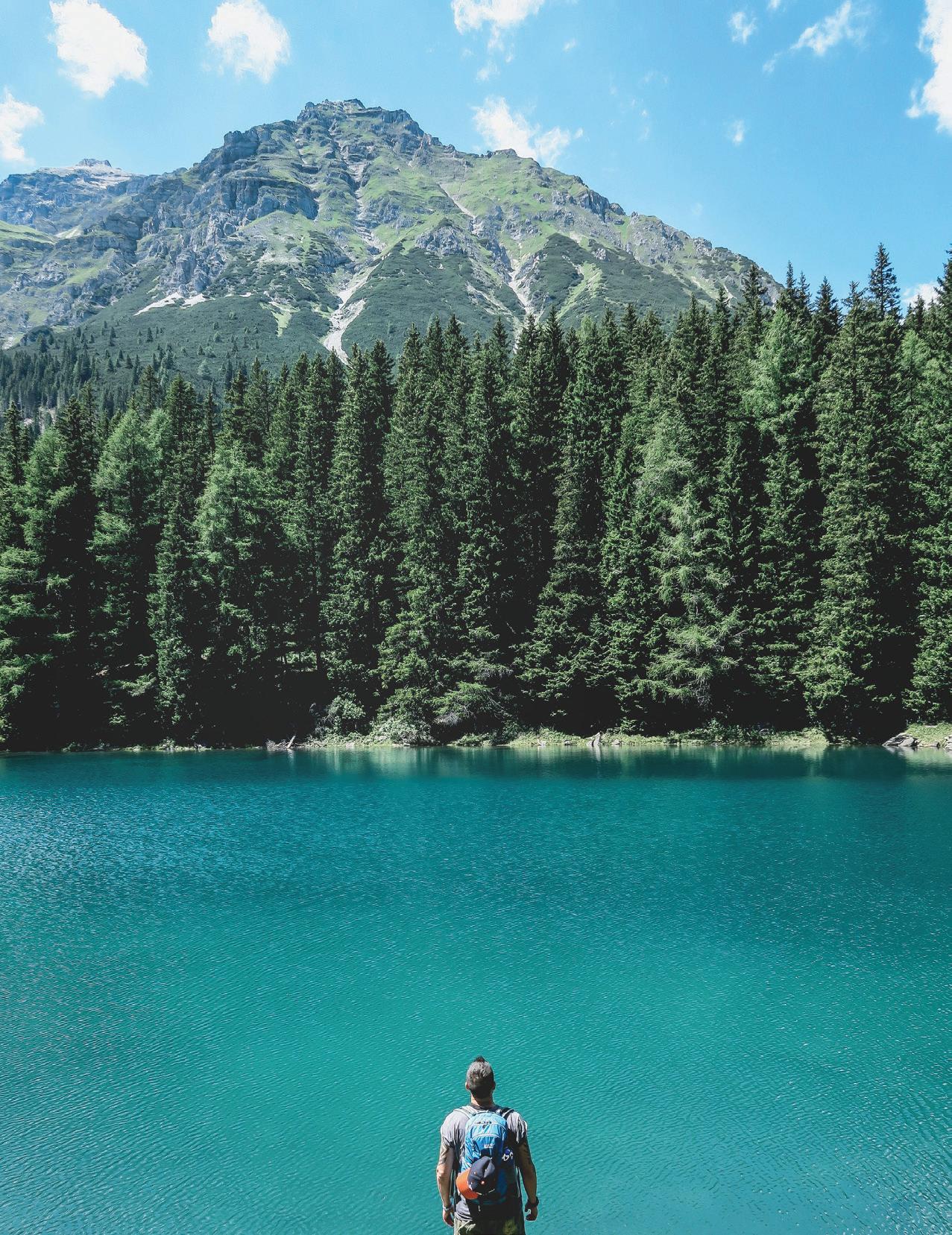
BY KAREN DAY
For some people, bungee jumping or scuba diving in shark-infested waters is a day at the office. For others, dancing in public defines their greatest fear. But for most who have endured the recent months of isolation, solo backpacking in the wilderness simply sounds like a lot of heavy lifting only to end up in another place we can’t be with friends. Without cell reception. And with bears. So why bother?
Be prepared.
If you’ve read the plethora of bestselling memoirs on solo wilderness adventure, finding your inner strength and losing a limb seem to be common occurrences. And in real life and statistics, every backpacker faces real dangers. Freak storms, summer avalanches, getting lost or injured are predictable risks, even when not alone. However, there are also precautions and plans that reduce the odds of mishap for a group or a single, determined soul.
Before you buy your first trail guide, realize, your most important tool is your brain. “Be Prepared.” “Prepared for what?” someone asked Baden-Powell, an English soldier in 1907, as the Great War loomed.
“Why, for any old thing,” he replied. The Boy Scouts of America were founded on his motto in 1910. One hundred and ten years should be enough to prove good advice.
Here are the other life-saving requirements.
1. Study your maps. Determine your route beforehand. Know your bailout points if needed. 2. Carry a GPS responder device. It’s difficult to spell SOS in a surprise snowstorm if your leg is broken. 3. Bring medical gear. Band-aids work well for blisters but will help altitude sickness. 4. Know your equipment before you go. Set up your tent and rain fly. What temps can your sleeping bag withstand? Waterproof matches? How does your water purifier operate? 5. Pack and carry your backpack for an hour with whatever you intend to carry in. Climb the stairs at home 10 times. If you’re exhausted, choose a beach trip. 6. Apply for a wilderness permit with a documented route. Share it with (sober) friends. Sign your name and date at the trailhead book and post an Instagram goodbye with photo of your vehicle. Don’t diverge from the trail! 7. Remember: Risk is not gender-specific in the wilderness. Neither is stupidity. Women and men alike can backpack safely alone with the right mind and equipment. However, according to emergency search and rescue statistics, 80 percent of searches are initiated by males and 12 percent don’t make it out alive, compared to 9 percent of women. Note to male self, do not pick up rattlesnake. 8. If you get lost or injured-STOP AND THINK! Don’t try to travel more than a short distance in any direction. If you have followed the rules, a search will be initiated where you were last seen. Send an emergency signal. Seek shelter. Drink water, slowly. Keep calm. Help will be on its way- eventually. Your job is to take care of yourself until it arrives.
Common sense aside, let’s deal with the biggest obstacle of all. Fear. It arrives in all kinds or disguises even before you set one lonely foot on the trail. There will be so many easy excuses to cancel. And yet, there is one amazing reason to keep going it alone. Just to remind yourself, if you can make it alone in the wilderness you can surely survive this scary, unpredictable world. Besides, imagine how badass your adventure will sound when you finally get to sit down with your friends!

And if fear or laziness wins, there’s always solo car camping.
Photo by Tommy Lisbin
“I was amazed that what I needed to survive could be carried on my back.
And, most surprising of all, that I could carry it.” –CHERYL STRAYED, WILD





